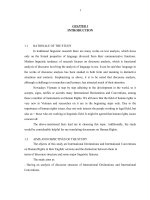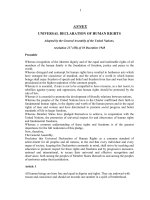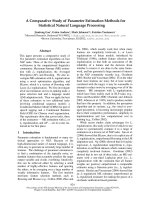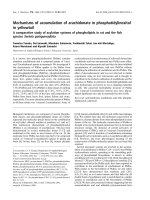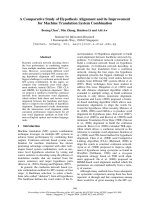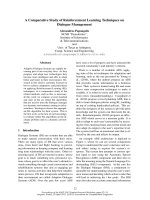When pauses become disfluencies a comparative study of huflis student interpreters english vietnamese versus vietnamese english interpreting performances
Bạn đang xem bản rút gọn của tài liệu. Xem và tải ngay bản đầy đủ của tài liệu tại đây (869.42 KB, 69 trang )
HUE UNIVERSITY
UNIVERSITY OF FOREIGN LANGUAGES
AND INTERNATIONAL STUDIES
FACULTY OF ENGLISH
----------
GRADUATE THESIS
WHEN PAUSES BECOME DISFLUENCIES:
A COMPARATIVE STUDY OF HUFLIS STUDENT
INTERPRETERS' ENGLISH-VIETNAMESE VERSUS
VIETNAMESE-ENGLISH INTERPRETING
PERFORMANCES
MAJOR: ENGLISH
Student: NGUYEN NGOC HUNG
Supervisor: HOANG THI LINH GIANG, PHD.
Hue, 4/2023
ĐẠI HỌC HUẾ
TRƯỜNG ĐẠI HỌC NGOẠI NGỮ
KHOA TIẾNG ANH
----------
KHÓA LUẬN TỐT NGHIỆP
KHI VIỆC NGỪNG, NGẮT GIỮA CHỪNG
KHIẾN BẢN DỊCH BỚT TRÔI CHẢY: NGHIÊN CỨU
SO SÁNH VỀ PHẦN THỂ HIỆN CỦA SINH VIÊN HUFLIS
KHI PHIÊN DỊCH TỪ TIẾNG ANH SANG TIẾNG VIỆT
VÀ TIẾNG VIỆT SANG TIẾNG ANH
NGÀNH NGÔN NGỮ ANH
Sinh viên thực hiện: NGUYỄN NGỌC HƯNG
Giảng viên hướng dẫn: TS. HOÀNG THỊ LINH GIANG
Huế, 4/2023
LỜI CAM ĐOAN
Tôi xin cam đoan kết quả đạt được trong khoá luận này là sản phẩm của
riêng cá nhân, không sao chép lại của người khác. Tất cả các tài liệu tham khảo
đều có xuất xứ rõ ràng và được trích dẫn hợp pháp.
Huế, ngày 17 tháng 4 năm 2017
Sinh viên thực hiện
i
ABSTRACT
Fluency is one of the key components one must master in interpreting,
given it is a cognitively demanding activity. Interpreting students are generally
cognizant of the need to improve fluency to perform better at their tasks but a lot
of them fail to grasp it, and thus they have encountered multiple obstacles while
seeking to ensure high-quality delivery. A common phenomenon that interferes
with student interpreters’ fluency is pauses during their performances for several
reasons. As a result, the purpose of this study is to present an overview of pauses
made by Hue University of Foreign Languages and International Studies
(HUFLIS) student interpreters, including how frequently they occur, their
influence on output, and their causes. Audio recordings of 36 students’ EnglishVietnamese interpretations and semi-structured interviews were the data sources
for this study. Participants recorded their interpretations after listening to one of
the speeches, for a total of two speeches to render and record. Five students
attended an interview about what they believed triggered their pauses whilst
rendering the target speeches. The study's findings revealed that students tended
to interpret from English (the A language) to Vietnamese (the B language) with
more and longer salient pauses overall. Also, all HUFLIS interpreting students
paused whilst taking the interpreting tests for various reasons, including issues
related to memorization, notes, anxiety, and difficulties when coming across new
words/structures. Based on the findings, this study discusses the implications,
limitations, and suggestions for further research.
ii
TĨM TẮT NGHIÊN CỨU
Phiên dịch vẫn ln là một hoạt động tư duy đòi hỏi nhiều yếu tố để thành
thạo, và một trong số đó chính là sự trơi chảy đến từ người dịch. Tuy nhiên, đó
lại là một khái niệm nhiều sinh viên phiên dịch có biết đến nhưng lại khơng hồn
tồn hiểu rõ và do đó mà gặp nhiều cản trở trong việc đảm bảo chất lượng bản
dịch. Điều đó cũng giải thích tại sao sinh viên có xu hướng ngừng, nghỉ trong
quá trình phiên dịch, và điều này có thể do nhiều nguyên nhân khác nhau gây nên.
Từ đó, nghiên cứu này được thực hiện với mục đích đưa ra một cái nhìn tổng thể
của việc ngừng nghỉ trong phiên dịch của sinh viên HUFLIS, bao gồm tần suất
sinh viên ngừng, nghỉ khi phiên dịch, tác động của việc ngừng nghỉ đến bản dịch
và những lý do tại sao điều đó lại xảy ra. Cơng cụ nghiên cứu bao gồm bản ghi
âm và phỏng vấn bán cấu trúc. Những người tham gia sẽ dịch và ghi lại bản dịch
của mình sau khi giảng viên nói xong một bài hoàn chỉnh, và tổng cộng sinh viên
cần làm hai bài như thế, một bài Anh-Việt và một bài Việt-Anh. Sau đó 5 sinh
viên sẽ được phỏng vấn về những nguyên nhân các sinh viên cho rằng làm cho
bản thân phải ngừng, nghỉ khi phiên dịch. Kết quả của nghiên cứu cho thấy tất cả
sinh viên phiên dịch của HUFLIS đều ngừng, nghỉ khi phiên dịch và họ đưa ra
những lý do như trí nhớ, ghi chú, lo âu và khó khăn khi gặp từ/cấu trúc mới.
Ngồi ra, tác động về mặt sư phạm, giới hạn của bài cũng như đề xuất cho những
nghiên cứu sau này cũng được thảo luận kỹ lưỡng ở cuối bài nghiên cứu.
iii
ACKNOWLEDGEMENT
I want to sincerely thank my supervisor, Dr. Linh Giang, for her
enthusiastic and wholehearted support and her sheer dedication. I would never
have been able to complete my graduation thesis if it were not for her.
I also want to express my gratitude towards the students who consented to
take part in the interview as their responses were tremendously beneficial to my
study.
iv
LIST OF ABBREVIATIONS
HUFLIS: Hue University of Foreign Languages and International Studies
CI: Consecutive interpreting
WM: working memory
FP: Filled pause
UP: Unfilled pause
v
LIST OF TABLES
Table 1. Descriptive Statistics of Salient Pauses in E-V vs. V-E interpretations
(N=33) ....................................................................................................................31
Table 2. Students’ E-V versus V-E interpreting performance: Comparing pauses32
Table 3. Motivations for pauses in Consecutive Interpretation ............................33
vi
LIST OF FIGURES
Figure 1. Average pause durations of individual students (seconds per minute)
(Participants 1-18) ................................................................................................. 27
Figure 2. Average pause durations of individual students (seconds per minute)
(Participants 19-36) ............................................................................................... 28
Figure 3. Average durations of salient pauses of individual students (seconds per
minute) (Participants 1-18) ....................................................................................29
Figure 4. Average durations of salient pauses of individual students (seconds per
minute) (Participants 19-36) ..................................................................................30
vii
TABLE OF CONTENTS
ABSTRACT ............................................................................................................ ii
TÓM TẮT NGHIÊN CỨU .................................................................................... iii
ACKNOWLEDGEMENT ......................................................................................iv
LIST OF ABBREVIATIONS ................................................................................. v
LIST OF TABLES ..................................................................................................vi
LIST OF FIGURES ...............................................................................................vii
CHAPTER 1: INTRODUCTION ........................................................................... 1
1.1. Background of the study ..................................................................................1
1.2. Rationale ........................................................................................................... 2
1.3. Aims of the study ..............................................................................................3
1.4. Scope of the study .............................................................................................4
1.5. Significance of the study .................................................................................. 4
1.6. Thesis Overview ............................................................................................... 5
CHAPTER 2: LITERATURE REVIEW ................................................................ 6
2.1. What is consecutive interpreting ...................................................................... 6
2.2. What are pauses in consecutive interpreting? .................................................. 7
2.2.1. Definition of pauses ................................................................................7
2.2.2 Types of Pauses ...................................................................................... 8
2.2.3. Impacts of pauses on interpreting performance ................................... 10
2.3. What makes interpreters pause during their CI performance? ...................... 11
2.3.1. Working Memory ................................................................................. 11
2.3.2. Note-taking ........................................................................................... 12
2.3.3. Anxiety ..................................................................................................12
2.3.4. Unfamiliar vocabulary in source speech ............................................. 13
2.4 Previous studies on pauses in interpreting ...................................................... 14
2.4.1. Previous studies on pauses in interpreting ........................................... 14
2.4.2. Summary ............................................................................................... 17
2.4.3. Research gaps ....................................................................................... 17
viii
CHAPTER 3: METHODOLOGY .........................................................................18
3.1 Research Context and Participants ..................................................................18
3.2. Research instruments ......................................................................................18
3.2.1. Students' recorded speeches in consecutive interpreting ..................... 18
3.2.2. Interview ............................................................................................... 20
3.2.3 Verbatim Transcription for interview data ............................................22
3.3. Procedures .......................................................................................................23
3.3.1. Test-taking ............................................................................................ 23
3.3.2. Interview conducting ........................................................................... 23
3.4. Reliability and validity ................................................................................... 24
3.5. Data analysis ................................................................................................... 25
3.5.1 Recordings ............................................................................................. 25
3.5.2 Interview data ........................................................................................ 25
CHAPTER 4: FINDINGS AND DISCUSSION .................................................. 26
4.1. The differences between student interpreters' pauses and hesitations when
they interpret from Vietnamese into English versus from English into
Vietnamese. ............................................................................................................26
4.1.1. Frequency ..............................................................................................26
4.1.1.1. Pauses in general ........................................................................26
4.1.1.2. Salient pauses ..............................................................................26
4.1.2 Duration ................................................................................................. 27
4.1.2.1 Pauses in general .........................................................................27
4.1.2.2 Salient pauses ...............................................................................29
4.2. Comparing student interpreters' pauses and hesitations when they interpret
from Vietnamese into English versus from English into Vietnamese. .................31
4.3. Causes of pauses in Consecutive Interpretation .............................................33
4.3.1. Memory .................................................................................................34
4.3.2. Note-taking ........................................................................................... 36
4.3.3. Anxiety ..................................................................................................38
4.3.4. Unfamiliar vocabulary/sentence structures in source texts ..................39
ix
CHAPTER 5: CONCLUSION .............................................................................. 41
5.1. Summary of Findings ..................................................................................... 41
5.1.1. What are the differences between student interpreters' pauses and
hesitations when they interpret from Vietnamese into English versus from
English into Vietnamese? .............................................................................. 41
5.1.2. What are the causes of students ' pauses and hesitations when
conducting Cl practice? .................................................................................. 41
5.2. Pedagogical Implications ................................................................................42
5.3. Limitations of the Study ................................................................................. 43
5.4. Suggestions for Future Research ....................................................................44
REFERENCES ...................................................................................................... 45
APPENDICES ....................................................................................................... 53
x
CHAPTER 1: INTRODUCTION
1.1. Background of the study
Humans all seem to be disfluent, according to Clark (2002), as they have
difficulty arranging their utterances. Disfluencies can also be utilized to inform
the audience that the speaker is having trouble. Gile (2009) recognizes that a
large percentage of student interpreters fail their final professional tests due to a
lack of proficiency in their working languages rather than a lack of interpreting
ability or cognitive ability. It is probably a prevalent hindrance in the field of
interpretation in particular and the production of speech in general, and the
research subjects of the present research are no exception. The ability to interpret
without hesitations proves to be of abundant importance in interpreting as it helps
us to guarantee the output quality when rendering the message from the source
language into the target language without compromising our flow. Another key
quality component is target-text fluency, since although listeners cannot always
make a comparison between the source and target text of an interpretation, and
thus target-text accuracy, they still believe they can assess the calibre of the
interpretation based solely on just what they hear and how the target text is
performed. Speech creation necessitates a complex interplay of activities on
several levels. Smooth functioning at each of those levels, from concept to
construction of what word to communicate and the proper manner in which to
assert it, via formulation, is necessary for fluency at the level of speech output.
Nevertheless, it is most likely for pauses to arise during speech production as
human speech is often filled with disfluencies. According to Fraundorf, Arnold,
and Langlois (2018), disfluencies are disruptions in the usual flow of speech, and
they happen regularly in spoken language because spoken speech is seldom
flawless. Some research has investigated whether some disfluencies should be
regarded as purposeful signals provided by a speaker to signify experiencing
brief difficulty with language creation, even though this theory is still being
disputed. Although disfluencies disrupt the flow of speech, they do not inevitably
1
impede understanding; in actuality, several more studies have determined that
disfluencies can even expedite comprehension in some situations, either by
heightened attention to the speech stream or by allowing a listener to foresee that
the speaker will next allude towards something tricky. As Ejzenberg (2000)
suggests, fluency is regarded as “proficiency that indicates the degree to which
speech is articulated smoothly and continuously without any ‘unnatural’
breakdowns in flow”. Nevertheless, a large number of student interpreters, more
than often, deal with silent and filled pauses. For some, they do more harm than
good, but for some, they may have a purpose to serve. Tree (1995) estimated that
around 6% of words said to have, or to be impacted by, some sorts of disfluency
based on an average of numerous research. Historically, these speech elements
were grouped together as "disfluencies" – linguistic fillers that detract from
productive discourse. However, none of this debate has made so-called
disfluencies any less widespread. And there are many variations in practically
every language, including sign language. Previous research suggests that the
durations of their hesitation vary depending on what language they are
interpreting. With a knowledge of the necessity of fluency in rendering one
language to another and how detrimental the inability to be fluent is to the output.
This study endeavours to gain further insight into the time differences in pauses
during interpreting English into Vietnamese and vice versa and grasp what leads
to students' hesitations during their performance. Hopefully, students will know
what is happening to them in terms of their tendency to pause as well as adopt
potentially helpful ways of refining their interpretations whilst performing in
real-time after understanding why they are inclined to stop amid the process.
1.2. Rationale
As an interpreting student, I thoroughly recognize the significance and
potential of this study for student and professional interpreters since I have also
encountered circumstances which necessitated me to halt during the process,
rendering my performance less fluent. In actuality, this is a relatively common
phenomenon that most interpreters experience, and when prompted why they did
2
so, people presented a multitude of justifications; there were even a few
individuals who had no idea of how to respond at all, claiming that they merely
paused because they just did. Many people, understandably, do not entirely grasp
why they pause and cannot justify why they do so, most likely due to a lack of
attention and research on the topic.
I, much like others, had little or no knowledge about pauses initially. Yet,
after carrying out a lot of research on the subject, I discovered a considerable
amount of novel and insightful findings, and thus I wanted others to learn more
about pauses also. Others picked up on this knowledge and employed it to dispel
their grave reservations regarding pauses and interpretation. Another significance
to enhancing our understanding of pauses is that if interpreters can eventually
grasp the concept of pauses in interpreting, they will be more likely to
manipulate and exploit them to their advantage.
Thereupon, my earnest hope in conducting this research is to identify the
aetiology of the abovementioned phenomena and draw beneficial findings that
can assist inexperienced and seasoned interpreters alike. These insights might be
of tremendous help to individuals who wish to develop their talents and
credentials in the field of interpretation. Will further, I intend on being able to
enrich the reference material on the topic of pauses and the interpreting field,
which has not garnered much attention from the general public and researchers.
This study also aims at presenting and interpreting the perception of HUFLIS
students on the pausal phenomenon. Furthermore, I expect this study will yield
new data that may be a topic for future studies on this field as there is a need for
more explicit and further refined discussion on it.
1.3. Aims of the study
This study endeavours to gain further insight into the time differences in
pauses during interpreting English into Vietnamese and vice versa and grasp
what leads to students' hesitations during their performance. Hopefully, students
will know what is happening to them in terms of their tendency to pause as well
as adopt potentially helpful ways of refining their interpretations whilst
3
performing in real-time after understanding why they are inclined to stop amid
the process.
• Research question(s)
This study seeks to answer two research questions:
1. What are the differences between student interpreters' pauses and
hesitations when they interpret from Vietnamese into English versus from
English into Vietnamese?
2. What are the causes of students ' pauses and hesitations when conducting
Cl practice?
1.4. Scope of the study
The present research is carried out at the University of Foreign Languages
and International Studies and involves 35 senior students whose sub-major is
interpretation. The aim of this study is to investigate the frequency of pauses in
the interpretation production as well as what factors to which the phenomena can
be attributable. Explanations as to why they paused are also revealed and
addressed.
1.5. Significance of the study
The sphere of interpretation will hopefully achieve sustained competitive
advantage now that we have a deeper look at what pauses are, why they occur,
and how they influence our performance as a result of the comprehensive
exploration of this study on pauses as disfluencies with many aspects of it
covered.
In this regard, the study will provide interpreters, whether novice or
seasoned, with comprehension into fathoming and producing higher-quality
interpretations. Furthermore, by analyzing hitherto unexplored areas, student
interpreters will gain a new perspective on how to account for pauses, along with
what to expect and how to deal with this occurrence.
Additionally, the overview presented in this research will push for a fresh
point of view, which will be relevant for future interpretation discussions.
4
1.6. Thesis Overview
Chapter 1: INTRODUCTION. This chapter provides the background of the
study, rationale, aims of the study, research questions, scope of the study,
significance of the study and the overall structure of the study.
Chapter 2: LITERATURE REVIEW. This chapter discusses consecutive
interpreting, definition of pauses, impacts of pauses and explanations for pauses.
Chapter 3: RESEARCH METHODOLOGY. This chapter describes the
methodology used in this study, consisting of subject selection, data acquisition
method and data analysis method.
Chapter 4: FINDINGS AND DISCUSSION. This chapter will give a
thorough discussion of the pauses' frequency, length characteristics, and the
reasons behind them.
Chapter 5: CONCLUSION. This chapter will include responses to the
study's research questions. Pedagogical implications, limitations, and suggestions
for further research are also included.
5
CHAPTER 2: LITERATURE REVIEW
2.1. What is consecutive interpreting
Russell (2005) suggested the interpreting process after a speaker or signer
has communicated one or more concepts in the source language and pauses while
the interpreter speaks is referred to as consecutive interpreting (CI). The
interpreter writes down what is spoken by the speaker. The interpreter does this
by sitting close to the speaker and taking notes using a pen and notebook.
Consecutive interpretation (CI) is an oral translation that happens right after a
speaker pauses between portions of speech.
CI is an all-encompassing activity. Dam (1993) divided CI into two stages:
reception (when the interpreter listens to the original speech) and production
(when the interpreter creates the SL and where the interpreter delivers the speech
in the TL). Jones (1998), on the other hand, categorized CI into four stages:
hearing, comprehending, assessing, and reexpressing. Moreover, CI is deemed a
sort of verbal communication. The interpreter in a CI task listens to a segment of
source language input and then recalls what was expressed in the input as
accurately as feasible in another language. Additionally, interpreters may process
the source language information in parallel, meaning that interpreters may have a
more effective strategy for processing the source language, enabling them to
retain specifics and increase performance in tasks involving verbal working
memory spans (Dong and Lin, 2013).
As per Gile (1995), consecutive interpreting is conducted in two stages:
comprehension (or listening and note-taking) and speech creation (or
reformulation). Moreover, Weihe (2007) claimed that consecutive interpreting
requires numerous competencies, including short-term memory, note-taking,
topic identification, target language rearrangement, and delivering an address to a
public audience.
6
It happens when an individual with limited English proficiency speaks,
followed by the interpreter's rendition of what was said to the English speaker.
There are pauses or breaks between remarks when each party speaks. In other
words, the interpreter listens first before interpreting. The interpreter uses
Consecutive Interpretation when the speaker finishes his or her words or
sentences. Interpreters take systematic notes while translating longer portions or
complete speeches (long consecutive). For brief passages spanning from one
word to a few lines, or for a bidirectional mode in a conversation interpreting
constellation (short sequential), CI can be conducted with or without notes, as
determined unilaterally by an independent interpreter (Pöchhacker 2016).
2.2. What are pauses in consecutive interpreting?
2.2.1. Definition of pauses
Significant contributions have been made by research devoted to
elucidating pauses. The literature review has indicated numerous research efforts
to examine disfluencies in the interpreting performance of both novice and
professional interpreters. There has been a lack of a unified definition of "pause".
For example, Hargrove and McGarr (1994) defined pauses as "physically
represented as a period in which no acoustic signal occurs for at least 200-270
msec’. Indeed, pauses are variable-length quiet gaps positioned between
linguistic units that can be likened to suprasegmental components (Simone 1990).
Pauses are defined as phenomena that halt the flow of speech and do not
contribute propositional meaning to an utterance (Gósy, 2007).
Disfluencies are generally characterized as pauses in the execution of a
speech plan (Postma et al., 1990). Speech disfluencies are also present in target
language output as a kind of linguistic production. As per Chu (2017), fluent
language is the consistency of the speech's flow in executing the creation of
speech smoothly, fast, constantly, and uninterruptedly.
7
Cenkova's (2014) definition of pauses shows that they can be interpreted as
disruptions in the flow of speech as well as significant shifts in intonation and
rhythm. They are converging in terms of how interpreters and listeners perceive.
Following Stuckenberg and O'Connell (1988), pauses are viewed as disturbances
to the flow of speech. Hargrove and McGarr (1994) define pauses as a period
during which no auditory signal occurs for at least 200-270 msec (McGarr 1994).
Hieke (1981) investigates the phenomenon of pause in speech production from
an integrated standpoint as well. He considers hesitations a vital aspect of
positive speech creation (Hieke 1981).
2.2.2 Types of Pauses
In
the
1950s,
Godman-Eisler
researched
speech
production
and
differentiated between breathing pauses and hesitation pauses. Breathing pauses
are created by the speakers' need to breathe, whilst hesitation pauses are
frequently induced by the cognitive work necessary for language output.
There are multiple sorts of pauses, but the two most common and common
are filled pauses (FP) and unfilled pauses (UP). Maclay and Osgood (1959)
offered the first classification of pauses, distinguishing between FP and UP. This
classification served as the foundation for much subsequent research.
Analogously, Mead (2000) determines that the most prevalent forms of pauses
are quiet and filled pauses. Cecot (2001) validates this view, believing that there
are two types of pauses: FP and UP.
Nonetheless, research shows that there are additional varieties, as Simone
(1990) proposes FP and UP are hesitation pauses that occur at non-grammatical
junctures. Hesitation pauses are categorised as filled and unfilled pauses.
Individual pauses and functional pauses are two further categories suggested by
Simone. The former are infrequent silence intervals caused by speakers'
communicative purposes or external circumstances, whereas the latter is at
grammatical junctures, such as beyond the limits of words and sentences.
8
Duez (1982) also examines silent and non-silent pauses in spontaneous
speech, such as political interviews and casual interviews, and meticulously
planned speeches, such as political speeches. Duez (1982) categorizes pauses as
silent, filled, false start, repetition, prolonged syllable, and articulated sequences
based on their stylistic role of directing the audience's attention to what is about
to be stated. While filled pauses are often associated with reluctance, the causes
of silence are diverse. Focusing on Grosjean's (1980) presumption of the
motivating generator of silence, notably discourse organization, physiological
needs of the person speaking, and perceptual operations. And finally, pauses
deemed associated with disruptions or disfluency were premised on coinciding
placements and occurrence in the numerous interpretations (Pradas Macías,
2006). These pauses equalled or exceeded 2 seconds in duration (salient pauses).
According to some research, filled pauses imply to the listener that the
speaker has something additional to convey. Filled pauses are usually linked with
hesitation since they are supposed to occur when speakers have to make choices
(Finlayson & Corley, 2012). Silent pauses, as opposed to filled pauses, are
generated by non-lexical utterances such as ah, mm, er, erm, uh, and um
(including breath pauses). Silent pauses are described as any stoppage in the flow
of speech displayed in the silent form, regardless of the cause for the pause or the
moment at which it is formed (Pradas Macas, 2006).
Fang and Zhang (2021) also focused on the long pauses that last 5 seconds
or longer by looking at the grammatical context in which they happened. We
discovered that these prolonged silences generally occurred more frequently at
grammatical junctures than at non-grammatical ones. They found that
participants who gave a lengthy pause intended to take additional time to think
through the translation of the following clause or sentence.
9
2.2.3. Impacts of pauses on interpreting performance
Whether the use of pauses serves is purposeful and serves any
communicative purpose remains unanswered and uncertain.
The way professionals look at pauses and how pauses influence interpreting
performance is heterogeneous in this field of study. Fluency proves indispensable
in evaluating interpretation output as studies have demonstrated their discoveries
on fluency in natural speech studies. Disfluencies, on the other hand, are
undeniably detrimental to speech fluency when they surpass permissible
boundaries. Research also suggests that disfluencies might impact language
understanding.
As per Goldman-Eisler (1958), silent pauses allow time acquisition during
the speech production process since it is significantly more challenging to guess
the initial lexical components following a quiet pause. This is also apparent for
Hargrove and McGarr (1994), who suggest that pauses provide time to structure
the discourse. They also genuinely think that pauses accentuate the new and most
important information in a sentence. Hence they serve as a potent communication
tool, as evidenced by research conducted by Tissi (2000), which revealed that
pauses make the message the speaker is attempting to impart more explicit and
intelligible to listeners.
Clark and Tree (2002) argue in detail that filled pauses adhere to the
'phonology, prosody, syntax, semantics, and pragmatics of English. They may be
employed to convey a range of interpersonal connotations and thus belong to the
word class of interjections, along with ah and oh. The findings of Arnold et al.
(2004, 2007) suggest that disfluencies that indicate reluctance appear to have a
direct impact on the understanding process. When spoken communication
contains a filler, such as “uh”, listeners can make an educated guess about what
will be said next.
10
Conversely, Brennan and Williams (1995) demonstrate the listeners'
sensitivity to fillers straightforwardly. They are inclined to deem the speakers
less confident in the occurrence of silence followed by an answer, with or
without a filler. Listeners base their evaluation on fluency of the interpreting
performance eminently.
However, it does not mean that speakers utilize them to communicate.
Although disfluencies may be uttered with communicative purpose, they may
also be the consequence of latencies in the speech plan, co-occurring with them
in ways that listeners might stochastically exploit. As a result, the assertion that
speakers utilize disfluencies to communicate is unquestioned, not due to it being
correct (or incorrect), but since it is tricky to verify (Finlayson and Corley, 2012).
Pauses are viewed by Clark and Wasaw (1998) as ways that inhibit the fluency of
spontaneous speech.
2.3. What makes interpreters pause during their CI performance?
The reasons why pauses occur in interpretation may vary. Previous studies
have examined the reasons for pauses in consecutive and simultaneous
interpreting.
2.3.1. Working Memory
Baddeley and Hitch (1974) developed the notion of working memory as a
restructuring of the concept of short-term memory in the 1970s. The key
distinction was that short-term memory was only a repository for information,
but WM was believed to be a cognitive component that combines storage,
processing, and executive control of the cognitive activities at hand. Working
memory (WM) is regarded as one of the most fundamental executive processes
required for higher-level cognitive processing, such as language processing and
language production. WM may alternatively be described as the brain's ability to
manipulate information sequentially while dealing with complicated cognitive
activities or simply the ability to keep and process discrete data in connection to
what a person is doing at any particular time. In effect, every interviewee
explicitly said that they paused due to not exerting sufficient memory effort, and
they claimed that this was an area of concern that affected student interpreters.
11
2.3.2. Note-taking
Notes are perceived as fundamental for aiding the seamless delivery of
interpreters in professional and academic settings. Note-taking skills are one of
the most crucial competencies that consecutive and liaison interpreters must have.
This method entails putting down the core concepts of the discourse and any
essential connections in a way that aids memory assistance for repeating the new
discourse. A good note-taking system assists an interpreter in analyzing the
source speech, and strong analysis using notes improves successful short-term
memory processes because notes show the skeleton of what was initially speech
or a set of thoughts in a certain sequence as opposed to a random jumble of
unconnected ideas (Gillies, 2017).
2.3.3. Anxiety
Despite the scarcity of empirical studies on the impact of stress on
interpreting performance, there is widespread agreement that anxiety is inherent
in both consecutive and simultaneous interpreting. It is undoubtedly true that
interpreting is a strenuous endeavour since it requires the performer to
accomplish a succession of complicated cognitive and psychomotor tasks for an
audience. According to interpretation experts, the capacity to handle anxiety (or
stress) is a prerequisite for good interpreters and a significant predictor of
interpretation skills. Nonetheless, many influences, notably non-cognitive ones
such as the emotional state of the test-takers, can be detrimental to the cognitive
performance of pupils who render from a foreign language (Luck & Vogel, 2013).
All students almost always encounter anxiety, which can render interpretations
less fluent even when the target language is the interpreters' mother tongue.
Evidence shows that interpreting causes worry and tension in the interpreter
(Kurz, 2003).
So how can anxiety impact target language delivery fluency in interpreting?
The attentional control hypothesis of anxiety (Eysenck et al., 2007) is a wellknown theory that examines how anxiousness impacts cognitive function (which
includes interpreting). Anxiety and interpretation, according to Zhao (2022), are
12
inextricably linked. Interpretation, as Jimenez and Pinazo (2001) affirm, is a
highly anxiety-provoking activity.
Besides, anxiety affects other aspects as well, like memory, taking notes,
concentration, and the ability to think critically, since nervous pupils find it
difficult to think properly and recollect the essential knowledge or revisit the
notes to ensure their understanding. Some students specifically said that they
experienced a range of worries, such as the fear of mispronunciation,
misinterpretation, being judged, or other invisible but destructive fears. These
caused students to feel anxious while they were interpreting, posing challenges
for them to give the task their attention and energy without taking breaks to cope
with their feelings. Even if they were aware that the chunk would be disfluent,
they occasionally paused for a very long period, which can be attributable to
anxiety. Also, several individuals claimed that regardless of how well-prepared
they were before the translation, they experienced anxiety and worry at the start
even if they were unsure of the cause. They are aware that excessive concern will
make them stop, nevertheless. Even though research has identified anxiety as a
significant factor in both second language learning and interpretation
performance. As worry and stress have the potential to impair interpretation
skills, researchers have been interested in their effects for a long time.
2.3.4. Unfamiliar vocabulary in source speech
In addition, He (2007) attributed filled pauses in sequential interpreting to
high information density, unfamiliar proper nouns, the grammatical difference
between the ST and TT, external circumstances such as noise, loud accent or bad
English from the speaker, and interpreter quirks. Cecot (2001) finds pauses are
attributable to the lexical or syntactic on-line planning and the difficulty of
comprehending the message. This is rather intriguing as the conductor finds it
almost implausible to distinguish between the two reasons. Quite similarly,
lexical and grammatical difficulties are what Maclay and Osgood (1959) found in
their study: speakers tend to pause when making decisions regarding lexicon and
grammar during the process of interpretation. Goldmann-Eisler (1968)
13

